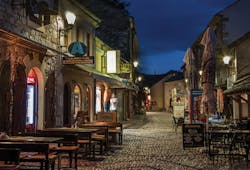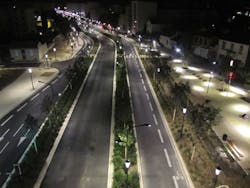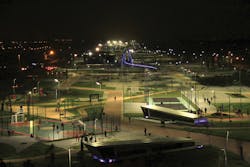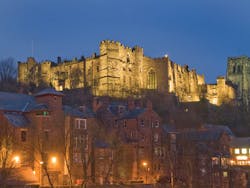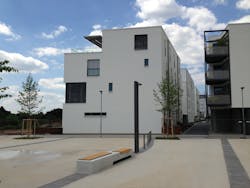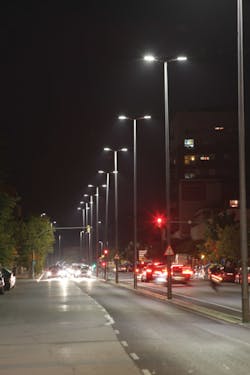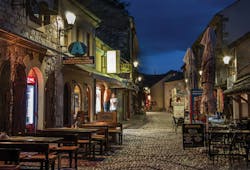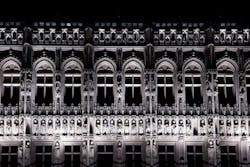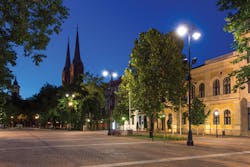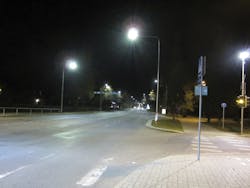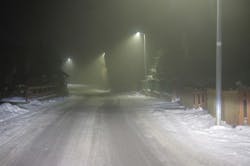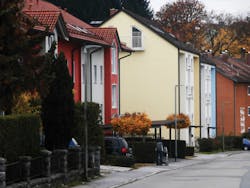Sustainable Lighting
At the Light Festival on December 7, 2013 in Lyon, France, lighting manufacturer Schréder and the LUCI (Lighting Urban Community International) network of cities focused on sustainable lighting announced the winners of the Auroralia 2013 Awards. This 5th annual program jointly organized by LUCI and Schréder identified urban projects in Nîmes, France; Ibarra, Ecuador; and Durham, England as first, second, and third prize winners, respectively. Moreover, Heidelberg, Germany won special recognition. The awards ceremony followed a judging session in November where jury members with vastly different backgrounds argued the merits of different projects in terms of the energy-efficient LED or other lighting involved, the applicability of controls and color capabilities, and the size and breadth of the various projects. Here MAURY WRIGHT highlights the winners and other impressive entrants.
Nîmes, France
The city of Nîmes and transportation authority Nîmes Métropole won recognition for a project focused on the urban community with a specific intent to accommodate pedestrians in terms of lighting and passageways and also novel lighting of the roadways that connect the city center to the A54 motorway. We covered parts of the project in an article last year. The project included LED-based lighting of pedestrian tunnels and walkways, and roadway lighting intended to guide traffic in and out of the city. The city said the project "brought human-scale comfort and safety" to the area while preserving the cultural value and aesthetics. Much of the project was a new installation so figures on energy savings were not available. But the average power of the LED luminaires used was 56W whereas many of the legacy luminaires used in the city were 150W. The panel appreciated the attention to aesthetics and the use of new types of fixtures that truly leveraged the advantages of LEDs in form factor and mounting options.
Ibarra, Ecuador
The city of Ibarra, Ecuador won for a lighting project encompassing a major urban park — Parque Bulevar Céntrica — located at the foot of the Imbabura Volcano. The 240,000-m2 area serves residents and tourists alike hosting cultural, entertainment, educational, and sports activities. The project was an excellent example of the combination of energy-efficient LED lighting with green energy sources — in this case a new hydroelectric supply — to enable a major sustainable project. The project delivered excellent lighting with 180 lx on sports areas and 75 lx on pedestrian and bicycle paths. Both figures were far greater than requirements. Yet the city projects 43% energy savings compared to if the park had been lit with legacy sources. The jury panel was impressed with the city’s determination to offer citizens and visitors a better quality of life while caring for the environment. Moreover, the development could lead to increased tourism and economic development.
Durham, England
The Durham, England project was focused on the UNESCO (United Nations Educational, Scientific and Cultural Organization) World Heritage Site comprising the Durham Castle and Cathedral. We covered this project in far more detail in this issue. The project was especially interesting as it involved an outdoor lighting system that had to do a brilliant job of lighting the iconic architecture while also protecting the local environment including preservation of the roosts of Pipistrelle bats. The jury panel lauded the lighting design for using a DMX control system and tunable lighting as it simultaneously limited the effects to mostly white hues that maintained the historical aesthetics and improved the visitor experience.
Heidelberg, Germany
Heidelberg, Germany nominated the redevelopment of an industrial area into a mixed-use business, entertainment, and residential district that will include a comprehensive environmentally-friendly footprint ranging from lighting to water use to power generation. The Bahnstadt project will ultimately be larger than the old city or Altstadt area and will include living space for a population of 5000 and 7000 jobs. The development will rely on passive house standards as a construction method and district-wide heating supplied by renewable sources. The outdoor lighting system will feature a comprehensive network for preventive maintenance and adaptive control based on the Owlet system, and LED luminaires in neutral and warm CCTs based on location. The jury felt that the Heidelberg project could become a great blueprint for new urban development and sustainable lighting, although the development was still in the very early stages of build-out at the time of the judging process.
Sabadell, Spain
Sabadell, Spain sought to install 7585 LED luminaires comprising 29% of the overall public city lighting as part of a program to meet European Union guidelines on energy efficiency. The city broke new ground by using an ESCO (energy services company) model to finance the lighting. ESCOs are fairly prominent in North America, but less so in Europe, especially in major lighting projects. The ESCO provided the upfront investment, and will recover the cost and presumably make a profit over the 10-year term of a maintenance contract. The installation also includes a network that enables adaptive control and automatic meter-reading capability for accurate determination of power usage. Sabadell projects energy savings equal to €1,040,000 ($1,431,000) per year and that likely equates to a good deal for the city and ESCO. Moreover, the city had sought to reduce light pollution. And the new luminaires accomplish the goal, eliminating uplight.
Los Angeles, California
The city of Los Angeles nominated a tunnel lighting project near Los Angeles International Airport on Sepulveda Boulevard — running underneath the airport runways. Los Angeles was a third-place winner in 2012 for its broader LED streetlight program that is the world’s largest. The 2013 project was perhaps the easiest of the 2013 entries to dissect in terms of LED-based lighting technology and the advantages afforded over legacy systems because the new installation replaced an existing high-pressure sodium (HPS) installation. A total of 572 LED luminaires replaced 750 HPS fixtures. Moreover, the city installed a network for control and automated maintenance. The baseline energy savings of the project are 70% and that figure could be increased through dimming the LED luminaires. The city also projects 75% savings in maintenance costs. But perhaps the most impressive result is the light quality. The city staggered brightness by zone to help drivers adapt to lighting changes with the time of day. Furthermore, the system uses an asymmetrical beam distribution that directs the lighting with the flow of traffic and eliminates driver glare. For more information on the challenges and benefits of LED tunnel lighting, see our recent feature.
Mostar, Bosnia/Herzegovina
Effective LED-based lighting projects aren’t just for major cities, as witnessed by the Mostar project that covers the Old City area and the Old Bridge, a zone protected as a UNESCO World Heritage Site. Moreover, the city did an outstanding job of maintaining the historic look, dismantling the legacy post-top lanterns with mercury vapor sources and sending them to Minel‐Schréder for refurbishment with Schréder’s LensoFlex 2 LED modules. The retrofit will reduce the total energy required to power the lighting from 55 kW to 10.6 kW. Savings are projected at 81% or 178,266 kWh per year. The project is being realized in a way that has minimum impact on residents and visitors and will ultimately result in far superior lighting and a better outdoor experience to go with the sustainability of the project.
Brussels, Belgium
Another lighting project of a UNESCO World Heritage Site was the focus of the entry from Brussels, Belgium. The city’s Grand Place has been relit in a dramatic fashion with a color-tunable system that can present dynamic effects. We covered the first phases of the project in late 2012 and featured it on our cover. The city has now completed the installation of façade lighting across all of the buildings surrounding the plaza. Select areas use LED projectors to display historic images on building walls. The Auroralia jury was fortunate to get a private tour of the Grand Place project and see a dynamic night-time program. Ironically, some of the jury questioned the justification for the use of colored lighting in the project and the value it brought to visitors. Others felt that the color programs could increase tourism and boost the economy, more than covering the price premium for the RGB fixtures. In any event, the LED lighting is 80% more efficient than the former lighting in the plaza and reduced maintenance cost by a factor of four.
Jyväskylä, Finland
The Kuokkala Bridge had undergone a retrofit of the architectural and façade lighting back in 2002, but until recently the roadway was lit by globe-shaped luminaires housing HPS lamps. The city of Jyväskylä and its citizens liked the globes that had become a recognizable element of the bridge’s architecture, but sought a more energy-efficient lighting option. Indeed, the bridge was arguably overlit with inefficient sources. The city ultimately replaced the fixtures with luminaires from Ketonen Oy that integrate an LED light engine from Valopaa Oy and new globes made by Elkamet. The city determined that the bridge needed a light level of 1 cd/m2 and the installation delivers 1.5 cd/m2 using 3000K warm-white sources. Even though cooler sources would have been more efficient the city is still realizing 74% energy savings that will yield an 11-year payback. The bridge was part of a broader city plan called Environmentally Friendly Outdoor Lighting that among other things has seen streetlights upgraded and networked.
Békéscsaba, Hungary
Békéscsaba nominated a downtown modernization project centered around Szent István square for the Auroralia Awards. The project included both new installation and retrofit of post-top and suspended acorn-style luminaires with Nagy-Kecskemet, Panon2, Terra Midi, and Terra Maxi LED fixtures from Schréder. We will get to the energy savings in a minute, but the city has received significant response from the public about the project. The city said 90% of the public reaction has been positive and that the residents have an increased appreciation for the importance of streetlighting. Moreover, the city said the broad-spectrum white light makes the buildings and monuments appear in their natural color and beauty, whereas the prior lighting had made them appear to have a yellow coat. The new lighting uses 6924 kWh less energy than the old lighting.
Tartu, Estonia
The city of Tartu has undertaken the first phase of a streetlight retrofit replacing around 500 legacy fixtures with LED luminaires. Even with the first phase the city decided to install adaptive controls that will adjust light levels based on the traffic present at different times of the night. The city projects energy and maintenance cost savings of €35,000 ($48,000). In its Auroralia application, the city specifically noted that the new lights would improve the quality of life for residents and visitors. Indeed, the nearby photo depicts excellent uniformity. And remember that the level can be reduced. The city also said that the new fixtures minimize light pollution.
Oldenburg in Holstein, Germany
The City of Oldenburg relies on tourism and foresaw LED lighting as a way to show residents and visitors that it was a forward-looking city with an environmental outlook. The city was concerned about carbon emissions and the impact of lighting on wildlife including the local bat population. By the end of 2013, the city had retrofitted all but 700 municipal fixtures to LEDs. The project has delivered 87% energy savings and reduced carbon by 184 tons. The city hopes to retrofit the remainder of its lighting this year. Payback for the entire project is expected to be five years, and the lights are rated for 35 years of life. The LED lighting is delivering light levels 20% higher than required.
The Auroralia jury was composed of journalists that cover the sustainable lighting space from a variety of angles ranging from enabling technologies such as LEDs to urban planning. The panel included Maury Wright of LEDs Magazine, Paul James of Mondo Arc, Britta Hölzemann of Licht, Charlotte Fauve of Ecologik, Albert Punsola of Ciudad Sostenible, Tom Rampelberghe of Light Partner, and Olivier Namias of Lux. There were no firm rules that guided the judging process but rather lengthy discussion interspersed with multiple rounds of balloting. The panel considered 26 city projects from Los Angeles to Russia to India.
Entries span the globe
In addition to the Auroralia entries featured in our main article, there were also entries from Lisbon, Portugal; Lyon, France; Hamburg, Germany; Chennai, India; Cairo, Egypt; Bryansk, Russia; Siófok, Hungary; Setúbal, Portugal; Rio de Janeiro, Brazil; Passau, Germany; Pocking, Germany; Medellín, Colombia; Málaga, Spain; and Marienhafe, Germany. The projects span the range of small district lighting retrofits to city-wide projects. Most of the projects were totally based on LED lighting, although a few include a mix of LEDs and the latest-generation HID products that are less efficient than LEDs but much improved over prior generations.
Consider the Cairo entrant, lighting of the new Cairo Festival City mixed-use development that will be home to 13,000 residents and 50,000 workers. The project utilizes 150W and 250W metal halide (MH) fixtures on main roadways and 53W LED luminaires on residential streets. The designers used DALI (digital addressable lighting interface) to connect the lights and enable dimming during low traffic hours. The development also includes a mix of LED and compact fluorescent (CFL) lighting for landscapes and building exteriors. The Cairo entry had perhaps the broadest array of different lighting applications and fixture types in the competition.
While there were a few new developments among the entries such as Cairo, more typically the projects were retrofits. For example, Siófok upgraded roadway and park lighting with more than 2000 LED fixtures. Traditional LED streetlights were the largest part of the project but it also included decorative style lighting in the downtown district. The retrofit project is delivering 555,324 kWh annual energy savings.
Passau is another city that realized substantial savings with the retrofit project nominated to Auroralia (shown here). The project included an upgrade of almost 2500 fixtures with LED lighting. Annual energy consumption went from 1,482,000 kWh to 300,000 kWh. Pocking is a smaller German city that installed 781 luminaires taking energy consumption from 235,000 kWh annually to 46,000 kWh.
Setúbal is another example of a project that used a mix of LED and HID lighting. The city used high-pressure sodium (HPS) to light some of the arterial roadways. But the downtown area is lit with LEDs and the city says that the project has resulted in its citizens making greater use of parks and walkways after dark. The new lighting maintains a historic look, and the city is saving 266,727 kWh annually. Indeed, the Auroralia Awards drew many noteworthy projects that both boost quality of life for residents and help trim global energy use and carbon emissions.
